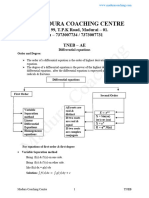Module-1 - Introduction To Differential Equations
Uploaded by
Chelse De guzmanModule-1 - Introduction To Differential Equations
Uploaded by
Chelse De guzmanBACHELOR OF SCIENCE IN CIVIL ENGINEERING
BACHELOR OF SCIENCE IN CIVIL ENGINEERING Example 3:
MATH 104 – DIFFERENTIAL EQUATIONS (𝑥 2 + 𝑦 2 )𝑑𝑥 − 2𝑥𝑦𝑑𝑦 = 0
𝑑𝑦
1st Semester, S.Y 2023 – 2024 May be written as, (𝑥 2 + 𝑦 2 ) − 2𝑥𝑦 𝑑𝑥 = 0
𝑑𝑥
Or (𝑥 2 + 𝑦 2 ) 𝑑𝑦 − 2𝑥𝑦 = 0
CHAPTER 1
We may consider either variable to be dependent, the other being the
INTRODUCTION TO DIFFERENTIAL EQUATIONS independent one.
1.1 DEFINITIONS 1.2 CLASSIFICATION OF DIFFERENTIAL EQUATIONS
A Differential Equation is an equation in which one or more of the derivatives of Differential equation can be classified according to its order, as ordinary or partial, and
one or more unknown functions occur. These functions, generally represent as linear or nonlinear equations.
quantities, the derivatives represent their rates of change, and the differential
equation defines a relationship between the two. Classification by Order:
This classification of differential equation is the most common of all.
The following are examples of differential equations: a. The order of a differential equation is the order of the highest-ordered
𝑑𝑦
1. = cos 𝑥, derivative appearing in the equation.
𝑑𝑥
𝑑²𝑦 Example:
2. 𝑑𝑥² + 𝑘 2 𝑦 = 0
𝑑𝑦
3. (𝑥 2 + 𝑦 2 )𝑑𝑥 − 2𝑥𝑦𝑑𝑦 = 0 1. = 𝑐𝑜𝑠𝑥
𝑑𝑥
𝜕𝑢 𝜕2 𝑢 𝜕2 𝑢 1
4. = ℎ2 (𝜕𝑥2 + 𝜕𝑦2 ) 2.
𝑑²𝑦
+ 𝑘²𝑦 = 0
𝜕𝑡 𝑑𝑥²
𝜕𝑢 𝑑2 𝑖 𝑑𝑖 1 𝑑²𝑖 𝑑𝑖 1
5. = 𝐿 𝑑𝑡 2 + 𝑅 𝑑𝑡 + 𝑐 𝑖 = 𝐸𝜔𝑐𝑜𝑠𝜔𝑡 3. 𝐿 𝑑𝑡² + 𝑅 𝑑𝑡 + 𝐶 𝑖 = 𝐸𝜔cos ωt
𝜕𝑡
𝑑²𝑦 𝑑²𝑥
Independence Variable – When an equation involves one or more derivatives 4. + 𝑑𝑡² = 𝑥
𝑑𝑡²
with respect to a particular variable. 𝑑4 𝑠
4
𝑑2 𝑠 𝑑𝑠
Dependent Variable – If a derivative of that variable occurs. 5. (𝑑𝑡 4 ) + 2(𝑑𝑡 2 ) + (𝑑𝑡 ) = 0
b. The degree of a differential equation is the algebraic degree of the highest-
Example 1: ordered derivative involved in the expansion. If the equation is in the fractional
𝑑²𝑖 𝑑𝑖 1
𝐿 𝑑𝑡² + 𝑅 𝑑𝑡 + 𝐶 𝑖 = 𝐸𝜔cos ωt form, simplify until a whole numbered exponent is obtained.
i = dependent variables Example:
t = independent variables 𝑑𝑥
L, R, C, E, and 𝜔 = parameters 1. = 𝑒𝑥
𝑑𝑦
Example 2: 𝑑2 𝑦
2. ( ) + 𝑏𝑦 = 0
𝑑²𝑣 𝑑²𝑣 𝑑𝑥 2
+ =0 𝑑3 𝑦 𝑑2 𝑦
𝑑𝑥² 𝑑𝑦²
3. (𝑑𝑥3 ) + 𝑥² (𝑑𝑥2 ) ³ = 0
4
v = dependent variables 𝑑4 𝑠 𝑑2 𝑠 𝑑𝑠
4. (𝑑𝑡 4 ) + 2(𝑑𝑡 2 ) + (𝑑𝑡 ) = 0
x and y = independent variables
ENGR. MELANIE ROSE P. PASCUA
BACHELOR OF SCIENCE IN CIVIL ENGINEERING
Classification as Ordinary or Partial Equations:
This classification depends on whether you have only ordinary derivatives involved or From the equation containing arbitrary constants, the constants may be eliminated by
only partial derivatives. the following methods:
a. Ordinary Differential Equation – this equation contains total derivatives and 1. By Differentiation and Combination. The General method to eliminate
does not contain partial derivatives which means that the unknown function arbitrary constants is to differentiate the equation n times. The n arbitrary
depends on only one independent variable. constants may then be eliminated from the n+1 equations. The result will be a
Example: differential equation of order n.
𝑑²𝑦 𝑑𝑦 2. By Isolation of the Constants. In this method at each step before
1. + 𝑑𝑥 = 3
𝑑𝑥²
differentiation, isolate one of the arbitrary constants, free from variable, so that
2. (𝑥 − 5)𝑑𝑦 = 2𝑥𝑦𝑑𝑦
𝑑𝑦
it will disappear after differentiation. Solve continuously until all constants are
3. (𝑥 2 + 𝑦²) 𝑑𝑥 = 5𝑥²𝑦 eliminated.
b. Partial Differential Equation – this equation contains partial derivatives which
means the unknown function depends on two or more independent variables. Example Problem:
𝜕𝑧 Obtain the differential equation from the following general solutions by eliminating
1. =𝑥 arbitrary constants.
𝜕𝑦
𝜕²𝑣 𝜕²𝑣 𝜕²𝑣
2. + 𝜕𝑧² = − 𝜕𝑧²
𝜕𝑥² 1. x³ - 3x²y = C
2. xsiny + x²y = C
Classification as Linear or Nonlinear
3. xy² - 1 = Cy 2
Another way that you can classify differential equations is as linear or nonlinear.
a. Linear Differential Equation – if it exclusively involves linear terms (that is, 4. 𝑥 = 𝐴𝑠𝑖𝑛 (𝜔𝑡 + 𝛽), 𝜔 a parameter, not to be eliminated.
terms to the power of 1) of y, y’, y’’, and beyond 𝑦 (𝑛) . For example, this equation 5. 𝑦 = 𝐶1 + 𝐶2 𝑒 3𝑥
is a linear equation: 6. 𝑦 = 𝐶1 𝑒 2𝑥 𝑐𝑜𝑠3𝑥 + 𝐶2 𝑒 2𝑥 𝑠𝑖𝑛3𝑥
𝑑³𝑦 𝑑²𝑦 𝑑𝑦
𝐿 +𝑅 +𝑄 = 𝐸(𝑥) 1.4 FAMILIES OF CURVES
𝑑𝑥³ 𝑑𝑥² 𝑑𝑥
This kind of differential equation may be written as, Ly’’’+Ry’’+Qy’=E(x) A family of curve on a plane is usually by an equation containing one or more
b. Nonlinear Differential Equation – involves nonlinear terms in any of y, y’, y’’, parameters together with the coordinates of a point on the plane. The differential
and beyond 𝑦 (𝑛) . For example equation of the family is obtained by eliminating the parameters by the method
𝑑³𝑦 𝑑2 𝑦 𝑑𝑦 discussed in the previous section.
𝐿 + 𝑅( 2 )² + 𝑄 = 𝐸(𝑥)
𝑑𝑥³ 𝑑𝑥 𝑑𝑥
Example Problem:
𝑑2 𝑦 𝑑𝑦
+ 2𝑏( )³ = 0 In the following problems, obtain the differential equation of the given families of curves
𝑑𝑥 2 𝑑𝑥 whose properties are indicated and sketch its curve.
1.3 ELIMINATION OF ARBITRARY CONSTANTS 1. Straight lines through the origin
We shall consider in this section the inverse process of obtaining the differential 2. Straight lines with slope and y-intercept equal
equation from the general equation from the general solution. This is done by 3. Circles with center at the origin
eliminating the arbitrary constants from the general solution. 4. Circles with center on the x-axis.
ENGR. MELANIE ROSE P. PASCUA
BACHELOR OF SCIENCE IN CIVIL ENGINEERING
5. Parabolas with vertex or the x-axis, with axis parallel to the y-aixs, and with
distance from focus to vertex fixed as a.
6. The cubics 𝐶𝑦 2 = 𝑥²(𝑥 − 𝑎) with a held fixed.
ENGR. MELANIE ROSE P. PASCUA
You might also like
- Dr. Firas K. AL-Zuhairi: Ordinary Differential EquationNo ratings yetDr. Firas K. AL-Zuhairi: Ordinary Differential Equation24 pages
- Module 1 Introduction To Differential EquationsNo ratings yetModule 1 Introduction To Differential Equations4 pages
- UNIT 4 First Order and First Degree - FinalNo ratings yetUNIT 4 First Order and First Degree - Final73 pages
- 1. Introduction to Differential EquationsNo ratings yet1. Introduction to Differential Equations27 pages
- Diff. Calc. Module 3 Chain Rule - PowerRule.Higher DerivativesNo ratings yetDiff. Calc. Module 3 Chain Rule - PowerRule.Higher Derivatives10 pages
- Polytechnic University of The Philippines: Title: Introduction To Differential EquationsNo ratings yetPolytechnic University of The Philippines: Title: Introduction To Differential Equations7 pages
- M2 Unit 1-First Order Ordinary Differential EquationsNo ratings yetM2 Unit 1-First Order Ordinary Differential Equations60 pages
- Separation of Variables: ENDEQN30 - Differential EquationsNo ratings yetSeparation of Variables: ENDEQN30 - Differential Equations18 pages
- Gen Math Module 6 Solving Exponential Equation and InequalitiespdfNo ratings yetGen Math Module 6 Solving Exponential Equation and Inequalitiespdf16 pages
- LECTURE 1 - Definition and Classifications of Differential EquationsNo ratings yetLECTURE 1 - Definition and Classifications of Differential Equations3 pages
- Lecture Notes Differential Equation - First Order ODENo ratings yetLecture Notes Differential Equation - First Order ODE49 pages
- 2nd PT-Basic Calculus-Final Exam-2022-2023No ratings yet2nd PT-Basic Calculus-Final Exam-2022-20234 pages
- POLYTECHNIC LECTURERS Differential EquationsNo ratings yetPOLYTECHNIC LECTURERS Differential Equations10 pages
- Introduction Order Degree Linear Non Linear and Elimination of Arbitrary ConstantNo ratings yetIntroduction Order Degree Linear Non Linear and Elimination of Arbitrary Constant26 pages
- Mathematics 1St First Order Linear Differential Equations 2Nd Second Order Linear Differential Equations Laplace Fourier Bessel MathematicsFrom EverandMathematics 1St First Order Linear Differential Equations 2Nd Second Order Linear Differential Equations Laplace Fourier Bessel MathematicsNo ratings yet
- Differential Equations (Calculus) Mathematics E-Book For Public ExamsFrom EverandDifferential Equations (Calculus) Mathematics E-Book For Public Exams5/5 (1)
- Algebraic Equations: An Introduction to the Theories of Lagrange and GaloisFrom EverandAlgebraic Equations: An Introduction to the Theories of Lagrange and Galois3.5/5 (1)
- OPC UA Part 2 - Security Model 1.03 SpecificationNo ratings yetOPC UA Part 2 - Security Model 1.03 Specification39 pages
- Overlapnet: Loop Closing For Lidar-Based SlamNo ratings yetOverlapnet: Loop Closing For Lidar-Based Slam10 pages
- Underground Fire Protection Pipes & EquipmentsNo ratings yetUnderground Fire Protection Pipes & Equipments6 pages
- Distant Space Travel Better As Family AffairNo ratings yetDistant Space Travel Better As Family Affair1 page
- PROPOSED CONSTRUCTION OF 2 CLASSROOMS AT NDEGE PRIMARY SCHOOLNo ratings yetPROPOSED CONSTRUCTION OF 2 CLASSROOMS AT NDEGE PRIMARY SCHOOL3 pages
- Trends On Curriculum Contextualization: Thursday, July 01, 2021 Department of Education Region VIII Leyte 1100% (1)Trends On Curriculum Contextualization: Thursday, July 01, 2021 Department of Education Region VIII Leyte 134 pages
- Comprehensive Systematic Review On Virtual Reality For Cultural Heritage Practices Coherent Taxonomy and MotivationsNo ratings yetComprehensive Systematic Review On Virtual Reality For Cultural Heritage Practices Coherent Taxonomy and Motivations17 pages
- Organic Chemistry 100 Must-Know Mechanisms (Roman A. Valiulin) (Z-Library)No ratings yetOrganic Chemistry 100 Must-Know Mechanisms (Roman A. Valiulin) (Z-Library)288 pages
























































































